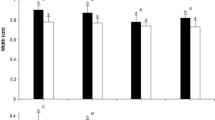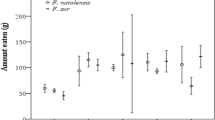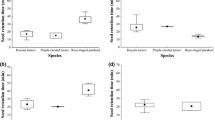Abstract
Utah juniper (Juniperus osteosperma) is one of many plant species that produce large numbers of fruits containing parthenocarpic or otherwise empty or inviable seeds. We tested the hypothesis that production of empty fruits in this species results in reduced levels of predation on fertile seeds. In a population in west-central Utah, we estimated the proportion of fruits with filled seeds in trees suffering high levels of fruit destruction by the seed-eating bird Parus inornatus and in neighbouring trees similar in crown and fruit-crop size but suffering negligible predation. We found that the heavily attacked trees had higher proportions of filled seeds. Thus, juniper may benefit from producing fruits that contain no offspring. This is the first study to demonstrate that empty seeds may reduce predation by vertebrate seed eaters and the first to demonstrate discrimination based on seed filling at the level of whole plants.
Similar content being viewed by others
References
Adams, R.P. (1993) Juniperus. In Flora of North America North of Mexico, Vol. 2 (Flora of North America Editorial Committee, eds), pp. 412–420. Oxford University Press, New York.
Coetzee, J.H. and Giliomee, J.H. (1987) Seed predation and survival in the infructescences of Protea repens (Proteaceae). S. Afr. J. Bot. 53, 61–64.
Crane, J.C. (1986) Pistachio. In CRC Handbook of Fruit Set and Development (S.P. Monselise, ed.), pp. 389–399. CRC Press, Boca Raton, FL.
Dogra, P.D. (1967) Seed sterility and disturbances in embryology in conifers with particular reference to seed testing and tree breeding in Pinaceae. Stud. For. Suec. 45, 1–97.
Fechner, G.H. (1976) Controlled pollination in eastern redcedar and Rocky Mountain juniper. Proceedings of the 12th Lake States Forest Tree Improvement Conference, U.S.F.S. Gen. Tech. Rep. NC-26, 24–34.
Grant, P.R. (1981) The feeding of Darwin's finches on Tribulus cistoides (L.) seeds. Anim. Behav. 29, 785–793.
Grundwag, M. (1976) Embryology and fruit development in four species of Pistacia L. (Anacardiaceae). Bot. J. Linn. Soc. 73, 355–370.
Jona, R. (1986) Hazelnut. In CRC Handbook of Fruit Set and Development (S.P. Monselise, ed.), pp. 193–216. CRC Press, Boca Raton, FL.
Jordano, P. (1989) Pre-dispersal biology of Pistacia lentiscus (Anacardiaceae): Cumulative effects on seed removal by birds. Oikos 55, 375–386.
Jordano, P. (1990) Utilización de los frutos de Pistacia lentiscus (Anacardiaceae) por el verderón común (Carduelis chloris). In Principios en etología (L. Arias, P. Recuerda and T. Redondo, eds), pp. 145–153. Monte de-Piedad, Córdoba, Spain.
Langerstedt, H.B. (1977) The occurrence of blanks in the filbert Corylus avellana L. and possible causes. Econ. Bot. 31, 153–159.
Lanner, R.M. (1983) Trees of the Great Basin: A Natural History. University of Nevada Press, Reno, NV.
Ligon, J.D. and Martin, D.J. (1974) Piñon seed assessment by the Piñon Jay. Anim. Behav. 22, 421–429.
Monselise, S.P. (ed.) (1986) CRC Handbook of Fruit Set and Development. CRC Press, Boca Raton, FL.
Mustart, P.J., Cowling, R.M. and Wright, M.G. (1995) Clustering of fertile seeds in infructescences of serotinous Protea species: An anti-predation mechanism? Afr. J. Ecol. 33, 224–229.
Nitsch, J.P. (1963) Fruit development. In Recent Advances in the Embryology of Angiosperms (P. Maheshwari, ed.), pp. 361–394. International Society of Plant Morphologists, University of Delhi, Delhi.
Niwa, C.G. and Overhulser, D.L. (1992) Oviposition and development of Megastigmus spermotrophus (Hymenoptera: Torymidae) in unfertilized Douglas-fir seed. J. Econ. Entomol. 85, 2323–2328.
Olson, B.E. and Richards, J.H. (1989) Grazing Effects on Crested Wheatgrass Growth and Replacement in Central Utah. Utah Agricultural Research Station Bulletin No. 516.
Schupp, E.W., Fuentes, M. and Gómez, J.M. (1996) Dispersal of Utah juniper (Juniperus osteosperma) seeds by lagomorphs. In Rangelands in a Sustainable Biosphere: Proceedings of the Fifth International Rangeland Congress, Vol. I (N.E. West, ed.), pp. 496–497. Society for Range Management, Denver, CO.
Scurlock, J.H., Mitchell, R.G. and Ching, K.K. (1982) Insects and other factors affecting noble fir seed production at two sites in Oregon. Northwest Sci. 56, 101–107.
Senar, J.C. (1981) On the Siskin's ability to discriminate between edible and aborted pine seeds. Misc. Zool. 7, 224–226.
Traveset, A. (1993) Deceptive fruits reduce seed predation by insects in Pistacia terebinthus L. (Anacardiaceae). Evol. Ecol. 7, 357–361.
Tueller, P.T. and Clark, J.E. (1975) Autecology of pinyon-juniper species of the Great Basin and Colorado Plateau. In The Pinyon-Juniper Ecosystem: A Symposium (G.F. Giûord and F.E. Busby, eds), pp. 27–40. Utah State University, Logan, UT.
Vander Wall, S.B. and Balda, R.P. (1977) Coadaptations of the Clark's Nutcracker and the Piñon pine for effcient seed harvest and dispersal. Ecol. Monogr. 47, 89–111.
Willson, M.F. and Burley, N. (1983) Mate Choice in Plants. Princeton University Press, Princeton, NJ.
Zangerl, A.R., Berenbaum, M.R. and Nitao, J.K. (1991) Parthenocarpic fruits in wild parsnip: Decoy defense against a specialist herbivore. Evol. Ecol. 5, 136–145.
Ziv, Y. and Bronstein, J.L. (1996) Infertile seeds of Yucca schottii: A beneficial role for the plant in the yuccayucca moth mutualism? Evol. Ecol. 10, 63–76.
Author information
Authors and Affiliations
Rights and permissions
About this article
Cite this article
Fuentes, M., Schupp, E.W. Empty seeds reduce seed predation by birds in Juniperus osteosperma. Evolutionary Ecology 12, 823–827 (1998). https://doi.org/10.1023/A:1006594532392
Issue Date:
DOI: https://doi.org/10.1023/A:1006594532392




